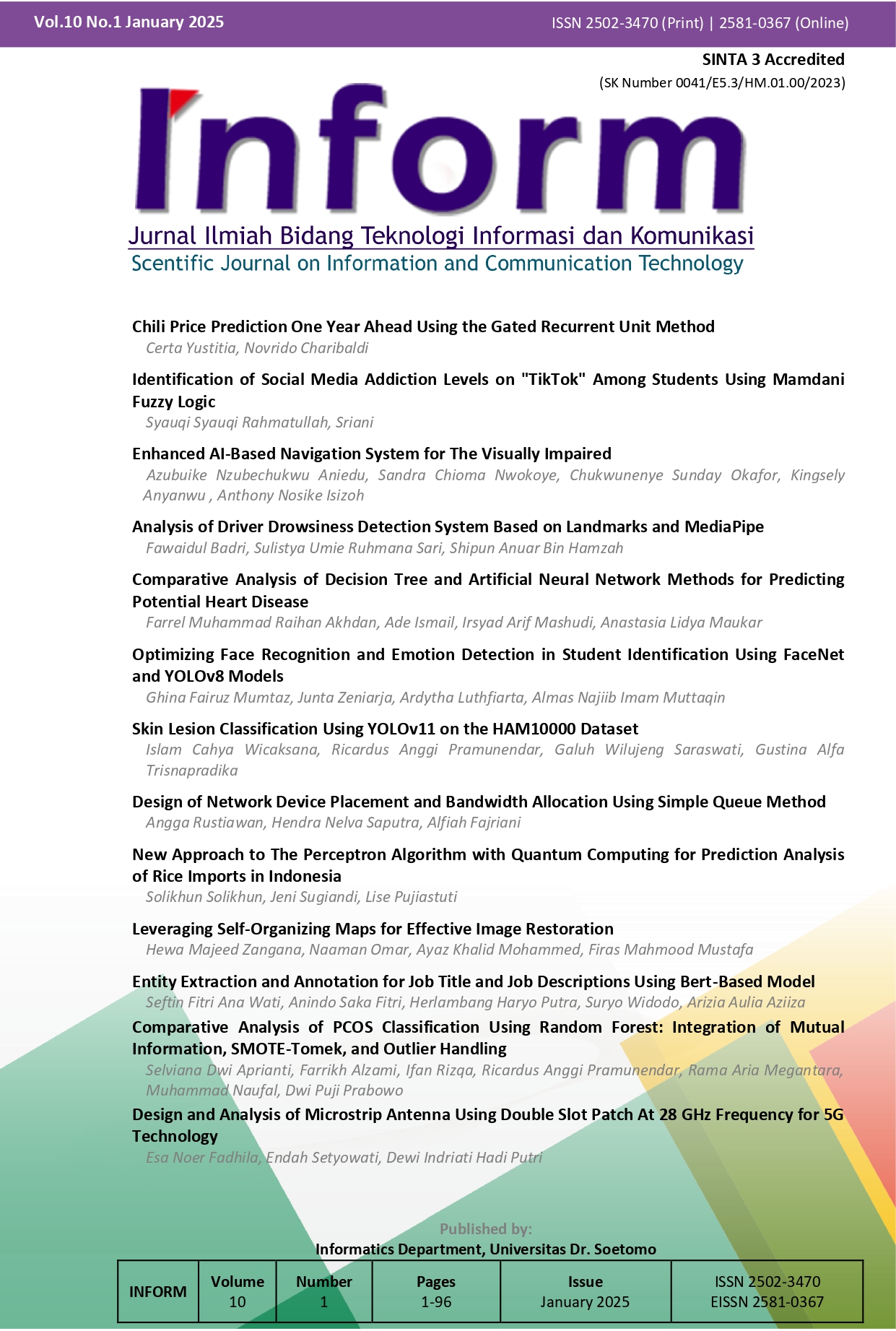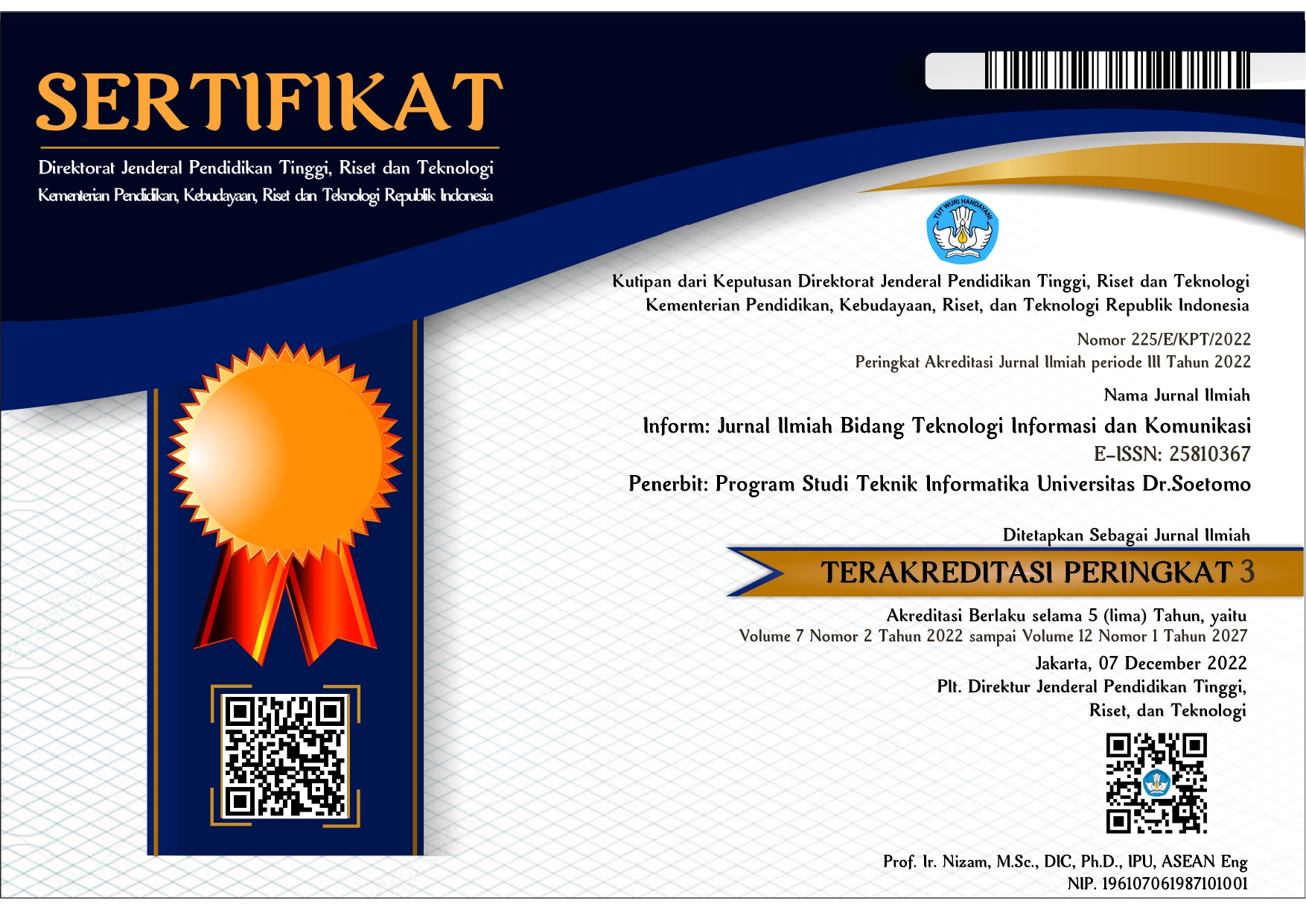Skin Lesion Classification Using YOLOv11 on the HAM10000 Dataset
 Abstract views: 324
,
Abstract views: 324
,
 PDF downloads: 239
PDF downloads: 239
Abstract
Skin cancer represents a significant global health concern due to its high mortality rate. Early and accurate detection is crucial but often hindered by the limitations of traditional diagnostic methods. This research applies the YOLOv11 algorithm for skin lesion classification directly from dermoscopic images using the HAM10000 dataset (10,015 images, 7 skin lesion classes). The primary objectives are to evaluate YOLOv11's performance in multi-class classification and assess the impact of data augmentation (rotation, horizontal flipping) in addressing class imbalance. The methodology involved two experiments: training YOLOv11 on the original and augmented datasets and comparing its performance with multi-stage architectures (VGG19 and ResNet50). Five pre-trained YOLOv11 models were tested using accuracy, precision, recall, and F1-score metrics. Results showed the YOLOv11x-cls model trained on the augmented dataset achieved the best performance among YOLOv11 models (accuracy 84.74%, precision 83.94%, recall 84.74%, F1-score 84.06%). However, VGG19 recorded the highest accuracy (89.68%). Data augmentation effectively improved model performance by mitigating class imbalance. This study also indicates that multi-stage architectures perform better in skin lesion classification tasks than single-stage architectures. The key contributions of this research are: (1) a comprehensive performance comparison of YOLOv11 with VGG19 and ResNet50 for skin lesion classification and (2) empirical validation of data augmentation's effectiveness in improving model performance. This study demonstrates that YOLOv11 can achieve competitive performance in skin lesion classification despite not surpassing the performance of multi-stage architectures.
References
S. Imani, G. Roozitalab, mahdieh Emadi, A. Moradi, P. BEHZADI, and P. Jabbarzadeh Kaboli, “The Evolution of BRAF-Targeted Therapies in Melanoma: Overcoming Hurdles and Unleashing Novel Strategies,” Front Oncol, vol. 14, Nov. 2024, doi: 10.3389/fonc.2024.1504142.
Z. Hayder, J. Alkufaishi, D. Amer, and A. A. Rahi, "Review of the cur-rent knowledge on the Types, pathogenesis, and prevention of Carcinoma Occurrence," 2024.
J. Reimann et al., "A Process Evaluation of the Skin Cancer Prevention Act (Tanning Beds): A Survey of Ontario Public Health Units," J Com-munity Health, vol. 44, no. 4, pp. 675–683, Aug. 2019, doi: 10.1007/s10900-019-00658-1.
K. Shehzad et al., "A Deep-Ensemble-Learning-Based Approach for Skin Cancer Diagnosis," Electronics (Switzerland), vol. 12, no. 6, Mar. 2023, doi: 10.3390/electronics12061342.
C. Dessinioti and A. J. Stratigos, "An Epidemiological Update on Indoor Tanning and the Risk of Skin Cancers," Nov. 17, 2022, NLM (Medline). doi: 10.3390/curroncol29110699.
S. S. Chaturvedi, K. Gupta, and P. S. Prasad, "Skin Lesion Analyser: An Efficient Seven-Way Multi-class Skin Cancer Classification Using Mo-bileNet," in Advanced Machine Learning Technologies and Applications, A. E. Hassanien, R. Bhatnagar, and A. Darwish, Eds., Singapore: Springer Singapore, 2021, pp. 165–176.
P. Agrahari, A. Agrawal, and N. Subhashini, "Skin Cancer Detection Using Deep Learning," in Futuristic Communication and Network Tech-nologies, A. Sivasubramanian, P. N. Shastry, and P. C. Hong, Eds., Sin-gapore: Springer Nature Singapore, 2022, pp. 179–190.
A. Naeem, T. Anees, M. Fiza, R. A. Naqvi, and S. W. Lee, "SCDNet: A Deep Learning-Based Framework for the Multiclassification of Skin Cancer Using Dermoscopy Images," Sensors, vol. 22, no. 15, Aug. 2022, doi: 10.3390/s22155652.
Y. Dong, L. Wang, S. Cheng, and Y. Li, "FAC-Net: Feedback attention network based on context encoder network for skin lesion segmentation," Sensors, vol. 21, no. 15, Aug. 2021, doi: 10.3390/s21155172.
B. S. Ankad, S. V Smitha, and V. R. Koti, "Basic Science of Dermosco-py," Clinical Dermatology Review, vol. 4, no. 2, 2020.
H. M. Ünver and E. Ayan, "Skin lesion segmentation in dermoscopic images with combination of yolo and grabcut algorithm," Diagnostics, vol. 9, no. 3, Sep. 2019, doi: 10.3390/diagnostics9030072.
A. Adebiyi et al., "Accurate Skin Lesion Classification Using Multi-modal Learning on the HAM10000 Dataset," May 31, 2024. doi: 10.1101/2024.05.30.24308213.
Y. S. Ingle and N. Faiz Shaikh, "Deep Learning for Skin Cancer Classifi-cation: A Comparative Study of CNN and Vgg16 on HAM10000 Da-taset," 2024.
S. Ćirković and N. Stanić, "Application of the YOLO algorithm for Med-ical Purposes in the Detection of Skin Cancer," in 10th International Sci-entific Conference Technics, Informatic, and Education, University of Kragujevac, Faculty of Technical Sciences, Čačak, 2024, pp. 83–88. doi: 10.46793/TIE24.083C.
S. Fotouhi, S. Asadi, and M. W. Kattan, "A comprehensive data level analysis for cancer diagnosis on imbalanced data," Feb. 01, 2019, Aca-demic Press Inc. doi: 10.1016/j.jbi.2018.12.003.
R. Khanam and M. Hussain, "YOLOv11: An Overview of the Key Ar-chitectural Enhancements," Oct. 2024.
M. A. R. Alif, "YOLOv11 for Vehicle Detection: Advancements, Perfor-mance, and Applications in Intelligent Transportation Systems," Oct. 2024.
Y. Wan, H. Wang, L. Lu, X. Lan, F. Xu, and S. Li, "An Improved Real-Time Detection Transformer Model for the Intelligent Survey of Traffic Safety Facilities," Sustainability, vol. 16, no. 23, p. 10172, Nov. 2024, doi: 10.3390/su162310172.
N. Jegham, C. Y. Koh, M. Abdelatti, and A. Hendawi, "Evaluating the Evolution of YOLO (You Only Look Once) Models: A Comprehensive Benchmark Study of YOLO11 and Its Predecessors," Oct. 2024.
V. Rajinikanth, A. N. J. Raj, K. P. Thanaraj, and G. R. Naik, "A custom-ized VGG19 network with concatenation of deep and handcrafted fea-tures for brain tumor detection," Applied Sciences (Switzerland), vol. 10, no. 10, May 2020, doi: 10.3390/app10103429.
D. Theckedath and R. R. Sedamkar, "Detecting Affect States Using VGG16, ResNet50 and SE-ResNet50 Networks," SN Comput Sci, vol. 1, no. 2, Mar. 2020, doi: 10.1007/s42979-020-0114-9.
Copyright (c) 2025 Islam Cahya Wicaksana, Ricardus Anggi Pramunendar, Galuh Wilujeng Saraswati, Gustina Alfa Trisnapradika

This work is licensed under a Creative Commons Attribution-ShareAlike 4.0 International License.
Authors who publish with Inform: Jurnal Ilmiah Bidang Teknologi Informasi dan Komunikasi agree to the following terms:
-
Authors retain copyright and grant the journal right of first publication with the work simultaneously licensed under a Creative Commons Attribution License (CC BY-SA 4.0) that allows others to share the work with an acknowledgment of the work's authorship and initial publication in this journal.
-
Authors are able to enter into separate, additional contractual arrangements for the non-exclusive distribution of the journal's published version of the work (e.g., post it to an institutional repository or publish it in a book), with an acknowledgment of its initial publication in this journal.
-
Authors are permitted and encouraged to post their work online (e.g., in institutional repositories or on their website) prior to and during the submission process, as it can lead to productive exchanges, as well as earlier and greater citation of published work.













